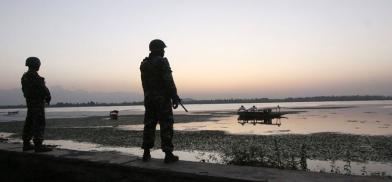Pakistan’s new strategy against India: Rebranding terror group network in Kashmir to create unrest
Pakistan has begun introducing new pawns in its old chessboard through The Resistance Front (TRF); intending to trigger mass unrest in the valley by enhancing the insurgents' legitimacy through a 'secular' approach and creating strong militant footholds while keeping the Indian armed forces pre-occupied, writes Aditya Gowdara Shivamurthy for South Asia Monitor

The conflict in Kashmir is multi-layered, which is a conflict for Kashmir (in between India and Pakistan) and a conflict within Kashmir (Pro-Pakistan/Pro-independence secessionists vs the Indian armed forces). So, when Article 370 of the Constitution of India was repudiated on August 5, 2019, the Indian government claimed that this policy would integrate Kashmir with India and end the conflict within.
This, however, had not affected the geopolitical and identity significance of Kashmir and thus has not altered Pakistan’s contest and claim for the region. However, while this Indian unilateral move has left Pakistan insecure and its Kashmir policy baffled, it has not rooted out Pakistan’s need for annexing Kashmir.
Thus, Pakistan has begun introducing new pawns in its old chessboard through The Resistance Front (TRF); intending to trigger mass unrest in the valley by enhancing the insurgents' legitimacy through a 'secular'approach and creating strong militant footholds while keeping the Indian armed forces pre-occupied.
The Resistance Front
The Resistance Front (TRF) broke into the scene of Kashmir insurgency post-August 5, which granted limited autonomy to Jammu and Kashmir under the Constitution by the Narendra Modi government, and continues to be the most active insurgent groups currently. Having claimed responsibilities for several dire attacks, TRF is considered to consist of rigorously hard-trained fighters. The origin of TRF is linked to Pakistan’s Kashmir policy of terror funding and sponsoring. Experts say using a neutral name such as TRF is a new strategy to portray the insurgency as an indigenous resistance moment. This might help Pakistan escape international scrutiny and Financial Action Task Force blacklisting, as the international community continues to tighten their screw against Pakistan.
Nonetheless, the role of TRF has been debatable; as some believe that it is an umbrella organisation for consolidating various militant organisations’ manpower, strength and weapons. While others see it is a seasonal organisation to divert attention from Pakistan and to create some operational space for established networks such as Hizbul Mujahideen (HM), Lashkar-e-Taiba (LeT) and Jaish-e-Mohammed (JeM).
However, one thing that remains less discussed is the role of TRF in creating legitimacy for the insurgency. Kashmir is said to have become a fertile ground for radicalization as the separatists are losing their ground and the grievances of Kashmiris are at an all-time high, with everyday human right abuses, revocation of Article 370, losing statehood, political alienation and inefficient panchayat powers. Thus leaving space for the TRF through its proactive social media presence, messages (written, audio and video), anti-Bharatiya Janata Party, and anti-domicile law rhetoric, along with targeting security forces, local leaders and BJP workers. Thus, filling the political and narrative vacuum through opportunistic extremist propaganda.
In the past, Pakistan has pushed its Kashmir policy with a religious and indigenous angle as seen with operation Gulmarg in 1947, operation Gibraltar in 1965 and the insurgency funding in Kashmir since 1989. But for more than a decade now, local recruits have been less than 200 per year, as Kashmiris prefer stone-pelting and protests over the insurgency. This is due to India’s intense counter-insurgency tactics and Pakistan’s impish policies.
For Kashmiris who perceive the Kashmiri problem as a non-religious issue, and are still loyal to Kashmiriyat and co-existence, joining pro-Pakistan insurgency has no relevance. Besides Pakistan’s Jihad has only undermined their moment and amplified violence in the valley. Thus, a new organisation that seems to have a non-religious, secular, and indigenous facade might provide legitimacy and exacerbate insurgency in the valley.
The Hizbul question
However, the emergence of TRF poses a severe question to the relevance of Hizbul Mujahideen (HM), another well-established indigenous pro-Pakistan militant organisation. HM is believed to be a part of the wider umbrella provided by the TRF and is merely coordinating and sharing intelligence with other organisations so that it can create some operational space.
But HM’s future remains elusive. HM was designated as a foreign terrorist organization by the United States in 2017. Having received its arms and funds from Pakistan, the organisation’s future is now left dwindling, as Pakistan has been very cautious about the FATF scrutiny. In addition to it, HM has been left faceless through the killing of its leaders such as Burhan Wani and Riyaz Naikoo and its local insurgent recruitment has also been low when compared to Pakistan’s LeT and JeM. A tentative HM-Pakistan rift is also visible as Naikoo and HM chief Syed Salauddin had expressed concerns over Pakistan’s preference to TRF and shortage of support, training, weapons and ammunition to HM. Security establishments have also claimed that Syed Saluhddin was attacked by the ISI to bring him in line with Pakistan’s policy.
Tap for India
While HM’s future stays debatable, it is nonetheless playing a major role in the trap that is being set up. By eliminating 155 militants in the first seven months of 2020, the government has expressed its success of Article 370 abrogation. Nonetheless more than half of the neutralised were HM militants with over 90 percent of them being locally trained by HM. Another surprising fact is that most of the causalities were locals with only 17 of them being foreign terrorists.
This is a dangerous trend where inter-operability of foreign and local fighters has seen an unfamiliar shift. Better trained fighters remain less neutralised and have shifted their bases to less populated areas and are in minimum contact with locals. The shift is mostly towards the North of Kashmir, as intense counter-insurgencies in South have fatigued the insurgents.
This has three implications; One the field is being vacated for local militants from TRF and HM to create legitimacy for the insurgency. Second, by placing local and less-trained fighters at the receiving end, as seen with the HM, counter-insurgency operations are persuaded to be centred around the South of Kashmir. Although, it is unclear if HM is at the receiving end for creating its own operational space or merely being left to fend by itself, (similar to how the Jammu Kashmir Liberation Front was abandoned when it no longer served Pakistan’s interests) it is still handy in engaging and distracting the counter-insurgency operations.
The third and final implications are that since counter-insurgency operations are focussed in the South, most of the well trained and foreign fighters seem to be shifting to the North of Kashmir. This shifting positions the insurgents closer towards the border, where they can be better supplemented with arms and cross-border reinforcements, while Pakistan keeps the Indian Army distracted through ceasefire violations. Consequently, in the first six months of this year, there have been over 2300 violations. In addition to it, insurgents in North Kashmir are well trained, dedicated, networked, and institutionalised, which complicates the security operations.
Thus, by keeping the army pre-occupied, the insurgent organisations are buying time for creating militant strongholds and legitimising insurgency. while helping create another mass uprising when time seems ripe for Pakistan to make its move.
(The writer is MSc International Relations graduate from the London School of Economics. The views expressed are personal. He can be contacted at gsaditya02@gmail.com; he tweets @gs_aditya)










Post a Comment